St John's Anglican Church
Nepean Highway, Sorrento
FIRST ORGAN: builder unknown, from St Andrew's Church, Clifton Hill; installed 1924
Restored 1964 Davis & Laurie, and 1980 R.J. Heatley
1 manual, 7 speaking stops, 1 coupler, mechanical action
Installed 2023 Our Lady of Good Counsel Catholic Church, Forestville, NSW Hargraves Pipe Organs
PRESENT ORGAN: built 1908 N.T. Pearce, Christchurch for Methodist Church, Woolston, NZ,
incorporating components supplied by Gray & Davison, London (job number 10791)
Alterations 1980 South Island Organ Co.
Removed 1981 to Christchurch Cathedral Grammar School Chapel
Dismantled c.2009-10 and placed in storage at South Island Organ Company, Timaru
Installed in present location 2019 Hargraves Pipe Organs Pty Ltd
2 manuals, 9 speaking stops, 4 couplers, mechanical action
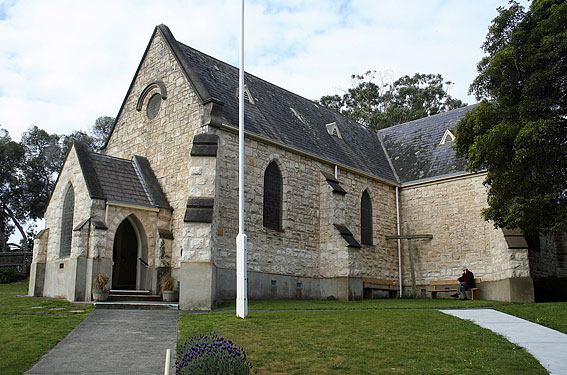
St John's Anglican Church, Sorrento - exterior
[photograph by Trevor Bunning [October 2018)]
Historical and Technical Documentation by John Maidment
© OHTA, 2006, 2020 (last updated February 2020)
The nave of St John's Church was built in 1874 by George Morce and constructed in massive blocks of limestone in a simple Gothic style with diagonal buttresses. The transepts were added in 1889 and the apsidal chancel in 1908-11. The stained glass includes a window from the original St Paul's Church, Melbourne by Ferguson & Urie and others by William Montgomery and Alan Sumner.1 The interior woodwork remains unvarnished with an attractive patination.
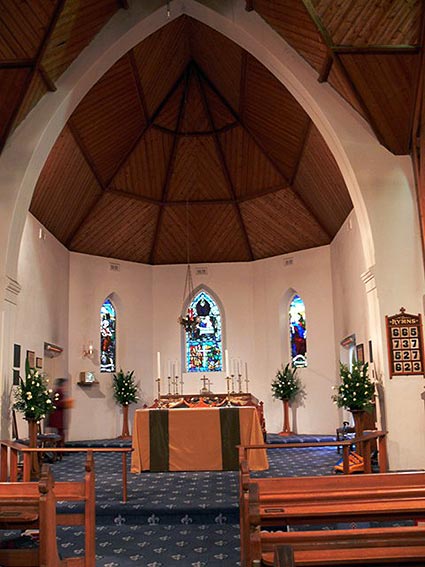
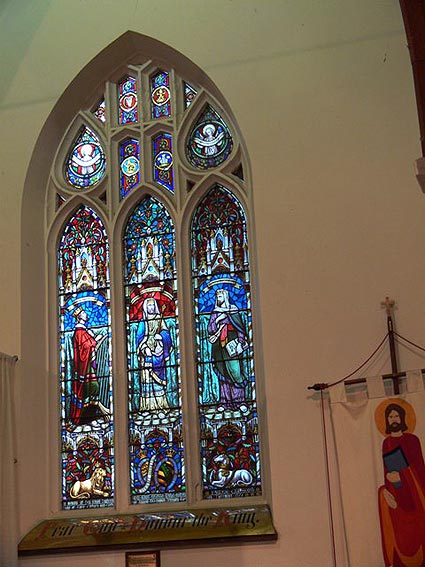
St John's Anglican Church, Sorrento –interior
[photographs by John Maidment [2006)]
First Organ.
The first organ in this church was of English origin and probably dated from the 1850s. There was no builder's plate and it has been difficult to identify the builder. It was installed at St John's Church in 1924 by George Fincham & Sons and came from St Andrew's Anglican Church, Clifton Hill, where it was replaced by a larger Fincham instrument from All Saints' Anglican Church, East St Kilda. It was the gift of Clements Langford in memory of his wife.2 The instrument was of interest for its attractive casework (later overpainted in white), with overhang, attractive cornice mouldings and three towers with ogee arches containing stencilled dummy pipes. The casework, originally varnished but subsequently overpainted on several occasions, may not belong to the internal parts of the instrument.3
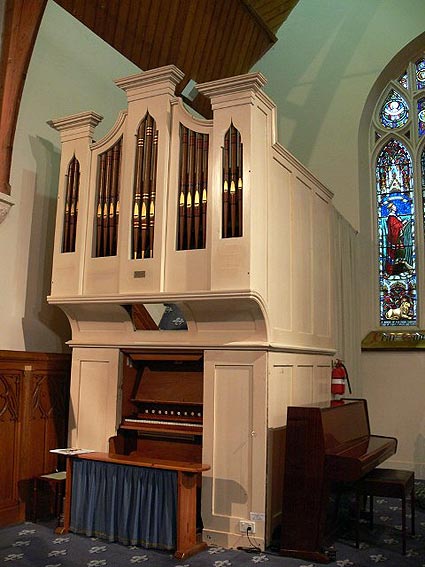
St John's Anglican Church, Sorrento – the first organ, dating from the 1850s
[photograph by John Maidment (2006)]
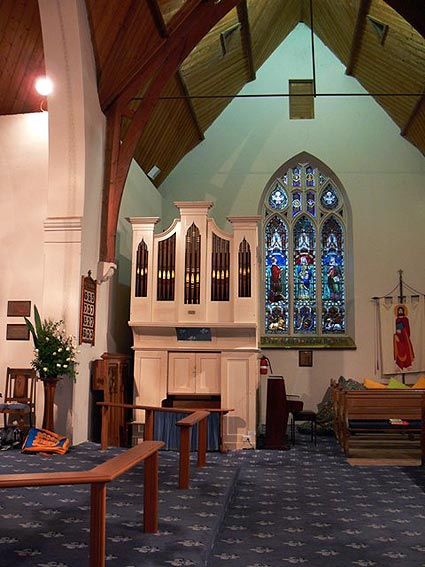
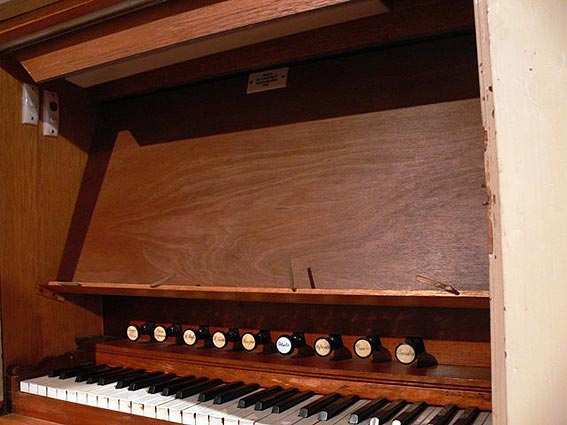
Two views of the first organ – case and console
[photographs by John Maidment [2006)]
The drawknobs retain their original script engraving, without pitch designations, and a tapered Bell Gamba is placed on the front slide. Restoration work was carried out in 1964 by Davis & Laurie and in 1980 by R.J. Heatley at which time some of the console woodwork, including the music desk, was replaced and the compass of the Pedal Bourdon extended.4
| MANUAL Open Diapason St Bafs St. Treble Principal Flute Fifteenth Gamba Manuel to Pedals PEDAL Bourdon |
[8] [8] [8] [4] [4] [2] [8] [sic] [16] |
CC-BB TC TC TC orig CC-C only |
Compass: 54/30
Mechanical action
Trigger swell lever.5
The organ was dismantled by Hargraves Pipe Organs in 2019 and then placed in storage. It was installed at Our Lady of Good Counsel, Forestville, NSW in 2023 by Hargraves Pipe Organs.
Present Organ.
The present two-manual organ of nine speaking stops was built in 1908 by Nicholas T. Pearce of Christchurch, NZ, for the Methodist Church, Woolston, NZ using components supplied by Gray & Davison, London (job number 10791).6 It had been overhauled in 1980 by the South Island Organ Company Ltd, who added an Octave 4ft to the Great Organ and moved the Harmonic Flute to the Swell, placed on a clamp at the rear.The organ was moved in 1981 to Christchurch Cathedral Grammar School chapel by Bernard Bicknell.
After the Christchurch earthquake, the building was dismantled and moved to Lyttelton. The Pearce organ was placed in storage in Timaru aound 2009-10 by the South Island Organ Company, and has been installed in its present location at Sorrento by Hargraves Pipe Organs Pty Ltd in 2019. It fits into a small footprint on the east wall of the south transept, speaking down the building, with the Pedal Bourdon placed at the side. The console fittings are of oak with Willis-style keycheeks, and the case timbers are of Kauri, clearly manufactured by Pearce. The zinc façade pipes retain their original stencilling.
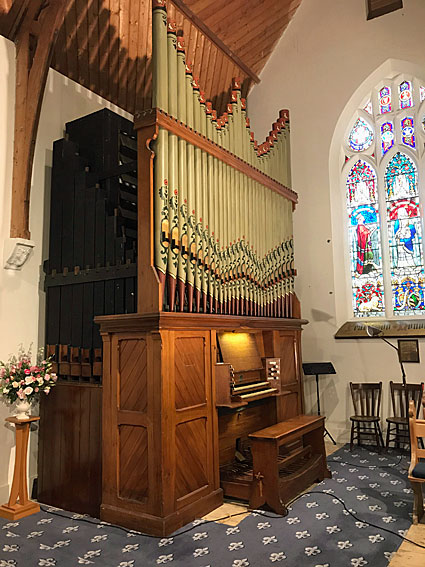
St John's Anglican Church, Sorrento – the present organ by N.T. Pearce organ
[photograph by John Maidment [ January 2020)]
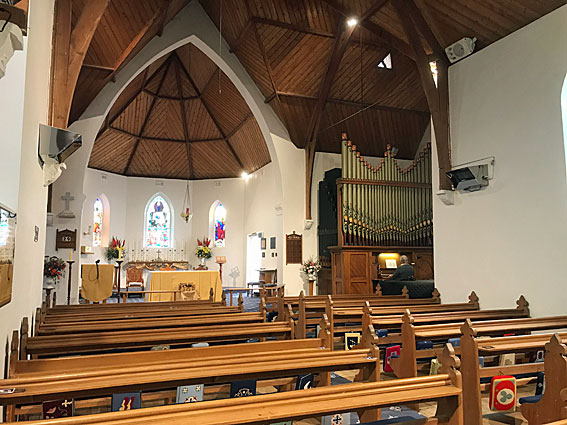
St John's Anglican Church, Sorrento – view of the Pearce organ from the nave
[photograph by John Maidment (January 2020)]
GREAT |
|
[SIOC 1980] TC [orig. on Great] |
Compass: 61/30
Attached drawstop console
Mechanical key and stop action
Balanced swell pedal
2 composition pedals to Great.7
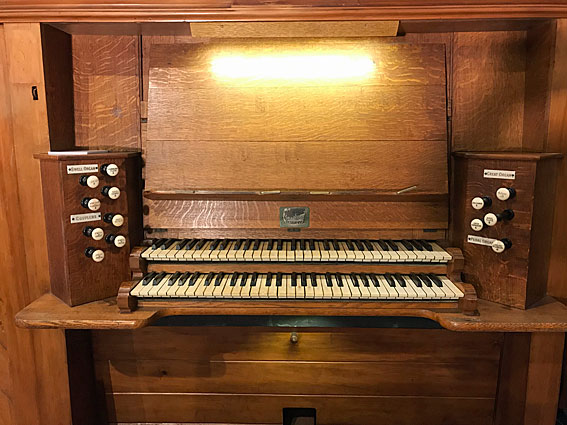
St John's Anglican Church, Sorrento – console of the Pearce organ
[photograph by John Maidment (January 2020)]
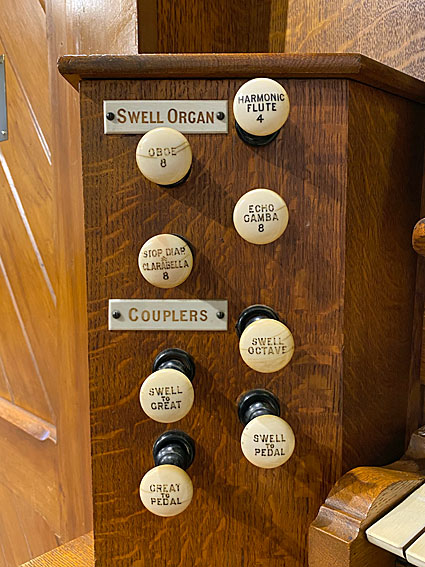
St John's Anglican Church, Sorrento – left-hand stop jamb of the Pearce organ
[photograph by Campbell Hargraves (November 2019)]
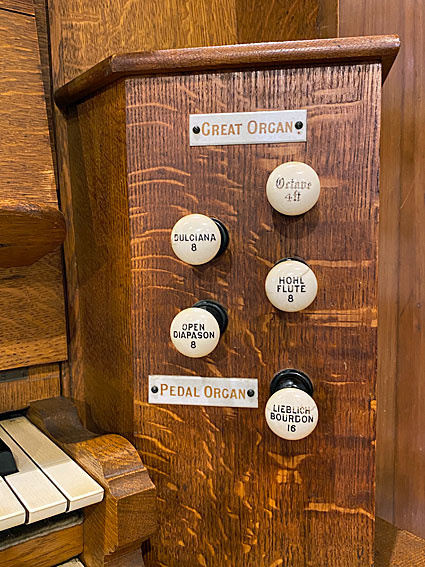
St John's Anglican Church, Sorrento – right-hand stop jamb of the Pearce organ
[photograph by Campbell Hargraves (November 2019)]
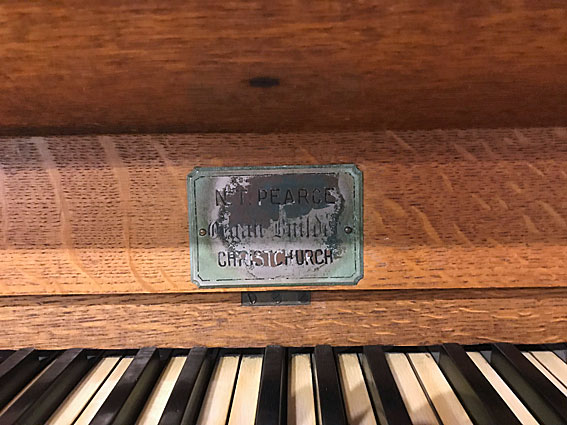
St John's Anglican Church, Sorrento – nameplate of the Pearce organ
[photograph by John Maidment (January 2020)]
1. Victorian Churches: their origins, their story & their architecture, ed. Miles Lewis ( East Melbourne: National Trust of Australia (Victoria), 1991), p. 121.
2 George Fincham Letter Books (1924); Enid Matthews, Colonial Organs and Oganbuilders (Carlton: Melbourne University Press), pp.127, 177.
3 Personal Communication from Campbell Hargraves to John Maidment and Geoffrey Cox, February 2020
4 Personal communication from Robert Heatley to John Maidment, 1979.
5 Specification noted by John Maidment, 1967.
6 Researched by Christopher Templeton in his 2010 paper "N.T. or not N.T. - that is the Question: A reassessment and evaluation of the work of Nicholas Thomas Pearce."
Available at: https://nzopt.org.nz/wp-content/uploads/2017/06/Pearce_Templeton_2010.pdf
7 Specification noted by John Maidment , 13 January 2020.